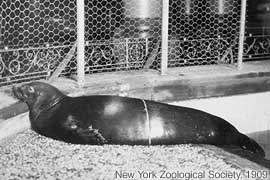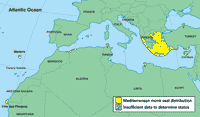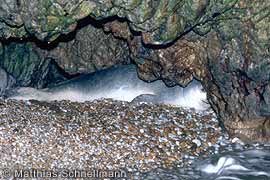|
HANGING BY A THREAD *
David M. Lavigne & William M. Johnson
Monk seals are among the rarest marine mammals on the planet. They need people-free coastlines to thrive, but in the Mediterranean, one of their last bastions, most coasts are crowded tourist hotspots. Does Europe’s monk seal face the same fate as its Caribbean cousin?
They can dive to depths of 200 metres or more, travel hundreds of kilometres between colonies, navigate mountainous seas with disarming nonchalance, dazzle onlookers with their agility, speed and grace, and detect fish movements with their whiskers. Even so, monk seals have failed to impress humans sufficiently to avoid being consigned to the extinct and endangered species lists of the twentieth century.
Monk seals were named by Johann Hermann in the eighteenth century after he watched a captured individual arching itself up against the edge of its container. He wrote, “It looked from the rear not dissimilar to a black monk in the way that its smooth round head resembled a human head covered by a hood, and its shoulders, with the short stretched feet, like two elbows protruding from a scapular…”
Three modern species are recognised: the Hawaiian monk seal Monachus schauinslandi, endangered, currently numbering 1,300-1,400 animals and declining at a rate of about 5 per cent per year; the Caribbean monk seal M. tropicalis, declared extinct by IUCN-The World Conservation Union in 1996; and the Mediterranean monk seal M. monachus, critically endangered and now thought to number fewer than 550 animals.
 |
|
|
|
Life’s a beach. A Hawaiian monk seal basks in the sun on Midway Atoll.
|
|
|
After surviving for millions of years, are these seals simply ‘relict species’, approaching the end of a natural evolutionary process? Are they no longer able to adapt to naturally changing environmental conditions? Or are humans to blame? Have we hunted them so extensively, and so disturbed and destroyed their habitats that they are simply unable to cope? To answer these questions, we need to go back to the very beginning of their story.
Monk seals are pinnipeds – a group of marine carnivores that includes true seals, fur seals, sealions and the walrus. Evidence now suggests that the pinnipeds first appeared in the north-eastern Pacific, along the coast of present-day California, some 23 million years ago. Initially, they radiated throughout the North Pacific, eventually entering the Atlantic Ocean via the Central American Seaway, an ancient waterway that once separated North and South America.
No one knows exactly when monk seals first reached Hawaii. Nor is it known if the ancestors of Hawaiian monk seals originated in the Pacific Ocean or in the Atlantic basin. What is known is that the Hawaiian monk seal is a ‘living fossil’, because some of its characteristics are more primitive than those of its earliest known relatives that lived on the east coast of North America 14-16 million years ago. Monk seals, therefore, could have made their way to Hawaii as early as 15 million years ago. Today, the Hawaiian monk seal inhabits the North-western Hawaiian Islands (NWHI) – the ‘Leeward Chain’ of largely uninhabited atolls and sandbanks curving off into the Pacific north-west of the main Hawaiian Islands. A few additional seals live and reproduce around the more densely populated main islands.
In contrast to the Mediterranean monk seal, for which records date back more than 2,500 years, nothing is known of the Hawaiian monk seal in antiquity – it was not even formally identified and named (by the German scientist Paul Matschie) until 1905. Written reports of its existence begin with the Russian explorer Lisianski, who in 1805 observed seals on the Hawaiian island that now bears his name.
Records from voyages of the Aiona in 1824 and the Gambia in 1859 suggest that the species was severely reduced by unregulated seal hunts in the early to mid-1800s. If Hawaiian monk seals were hunted to precariously low levels by the late 1800s, they must have staged a partial recovery during the first half of the twentieth century. But there is no documentation for this either, because the first range-wide scientific surveys did not start until the late 1950s. Since then, we know the population has declined by about 60 per cent.
The species was listed in the first IUCN Red Data Book of endangered mammals – published in 1966 – as ‘vulnerable’. In 1976, it was listed as a ‘depleted species’ under the US Marine Mammal Protection Act and subsequently declared an endangered species under the US Endangered Species Act. It was only then that dedicated long-term efforts to study and protect the Hawaiian monk seal were launched in earnest.
Threats confronting the species include accidental entanglement in fishing gear and other marine debris, deliberate killing by fishermen and a serious decrease in food availability affecting the largest surviving breeding colony. Though relatively low marine productivity in the region may be partly to blame, commercial fisheries are also implicated in the crisis, and have been accused of causing the starvation of an endangered species by overfishing the seal’s food sources.
Thanks to a last-minute Executive Order by Bill Clinton, monk seal habitat in the NWHI will soon be incorporated into the single largest protected area ever created in the US – the North-western Hawaiian Islands Coral Reef Ecosystem Reserve – designed to safeguard fragile coral reef habitat along the entire 1,930km of the Leeward Chain. The Presidential decree clearly emphasises a commitment to the precautionary principle, in which endangered species and habitats are given the benefit of the doubt over any temptation to indulge in fuzzy or uncertain science for the sake of economic interests.
|
 |
|
|
Fated seal. The only known photograph of a Caribbean monk seal – taken at Bronx Zoo in 1909. The species was formally declared extinct in 1996.
|
|
Returning to our journey through time, some ancestors of modern monk seals moved through the Central American Seaway, eventually establishing a foothold in the Caribbean. Again, the history of the Caribbean monk seal and its relationship with humans remains unclear, though we have found some evidence to suggest that native tribes hunted it for its meat and hides. The species appears to have entered its fatal tailspin only after Europeans first journeyed to the New World. Observing Caribbean ‘sea wolves’ on the coast of Santo Domingo in 1494, Columbus promptly ordered his crew to kill eight of the animals for food, paving the way for intensive exploitation of the species by settlers and traders who came in his wake. In 1707, the naturalist and physician Hans Sloane wrote that fishermen would catch 100 seals during a single night in the Bahamas, the animals’ blubber being melted down to produce lamp oil. Log-books from shipwrecked galleys also record that marooned sailors ate the seals. Some of the last surviving colonies were slaughtered for natural history museums. During a single expedition to the Triangles off the Yucatan Peninsula in December 1886, for example, collectors killed 42 Caribbean monk seals, whose stuffed bodies and constituent parts were subsequently sold to some of the world’s most prestigious institutions. According to conventional wisdom, the last authentic record of a living Caribbean monk seal dates to 1952, when a small colony was observed on Serranella Bank, south-east of Jamaica.
Since that time, sporadic observations of mystery seals in the Caribbean have been reported, much like UFO sightings [see Caribbean monk seals or hooded seals? this issue]. But there is no photographic evidence of these, and most observers cannot realistically be expected to distinguish between a Caribbean monk seal, another pinniped species or even a manatee. Some of the reported sightings have probably been of wayward young hooded seals Cystophora cristata, other North Atlantic seals beyond their normal range, or even escapees (including sealions) from captive facilities. To complicate matters, manatees and monk seals display a striking similarity when they float on the surface, a behaviour that, in both cases, reputedly contributed to the rise of mermaid legends.
Having reached the Caribbean, monk seals and their relatives continued their dispersal eastward through the Atlantic basin, eventually leaving one final species to colonise the Mediterranean and the coasts and adjacent islands of North-west Africa. In contrast to its tropical cousins, the Mediterranean monk seal, immortalised by such ancient luminaries as Homer, Aristotle, Hippocrates, Plutarch and Pliny, has long played a prominent role in human mythology and culture. Today, it clings to survival along desolate, cliff-bound coasts in Greece, Turkey, Madeira and along the Western Sahara. Most of the large colonies that once graced Mediterranean shores appear to have been wiped out during the Roman era as a result of intensive hunting for the seal’s pelt and fat, its meat and its perceived medicinal properties. In a startling indication of how little things have changed in 2,000 years, ancient texts also report how fishermen persecuted the species, angered by stolen catches and damaged nets.
For centuries thereafter, large herds continued to survive along the Atlantic seaboard of North-west Africa. It was not until 1434 that Portuguese explorers landed on these pristine coasts and discovered an estimated 5,000 ‘sea-wolves’ inhabiting the Rio d’Oro. According to the official chronicler of the expedition, the seals – presumably unaccustomed to the human threat – presented easy targets, and many were killed, their pelts destined for European markets. Similar expeditions wiped out herds in the Canary Islands and Madeira.
|
 |
|
|
Monachus monachus current distribution
(click to enlarge)
|
|
Though the species continued to survive in small colonies along many Mediterranean and Black Sea shores until the middle of the twentieth century, it has since faced a losing battle against a barrage of forces: mass tourism, coastal urbanisation, industrial overfishing and the wrath of traditional fishermen, who still see the seal as a convenient scapegoat for damaged nets and dwindling catches. A few decades were all that were needed to deplete and eradicate the species from entire regions.
Today, the monk seal is virtually extinct in the western and central Mediterranean, and in the Marmara and Black Seas. Though thousands of islands, inaccessible coastlines and the monk seal’s contemporary habit of shying away from human contact have all conspired to make population estimates an extraordinarily inexact science, the best guess is that only 379-530 individuals now survive. Those bleak statistics make M. monachus Europe’s most endangered marine mammal.
Habitat destruction and disturbance has, in some respects, been an even more lethal and enduring foe than hunters and hostile fishermen. Historical records tell us that herds of monk seals once occupied open sandy beaches, shoreline rocks and great arching caves in the Mediterranean. Since then, though, steadily increasing human pressures have driven the animals to colonise far more marginal habitats. Caves, many with underwater entrances and inner haul-out areas, continue to provide a refuge for resting, breeding and nursing, and yet there is evidence to suggest that even these habitats have continued to deteriorate as seals attempt to avoid harassment and disturbance. In recent years, seals have been seen in caves that are, in reality, little more than water-filled crevices. Animals using such shelters, which offer no beaches or haul-out areas, are obliged to sleep and rest while floating in the water.
 |
|
|
|
Suitable cave habitat for Mediterranean monk seals to rest, give birth, and nurse their pups has deteriorated over time, due to human harassment and disturbance.
|
|
|
Despite high-level overtures by the United Nations and others, the tourism industry has so far ignored pleas for it to play a constructive role in the conservation process. The stark fact remains that mass tourism poses a clear and present danger to the survival of the species throughout the eastern Mediterranean, even in the few monk seal protected areas that currently exist. Without a network of well-managed and well-guarded marine protected areas (MPAs) – a priority that has been recognised for at least 20 years – there can be little hope for the survival of the species.
The fate of the Mediterranean monk seal was again called into question in 1997, when its largest surviving colony on the Côte des Phoques in the Western Sahara, then numbering some 317 animals, suddenly fell by 70 per cent. The mass die-off led to considerable blood-letting among scientists and conservationists, unable to determine whether they were dealing with a toxic algal bloom (the most likely hypothesis) or a morbillivirus epidemic (see BBC Wildlife, July 1997). Incidental casualties of the die-off included a controversial Spanish plan to translocate some of the colony’s monk seals to the Canary Islands, and a related scientific research programme at odds with many in the monk seal conservation community because of its invasive methods.
Since then, Luis Mariano González of Spain’s Ministry of Environment has been leading efforts to implement a Regional Recovery Plan for the species under the auspices of the Convention on Migratory Species (also known as the Bonn Convention). The plan links the range states – Madeira (Portugal), the Canary Islands (Spain), Morocco and Mauritania – in an ambitious effort to set up a network of new and existing MPAs, and to monitor the population by non-invasive scientific means.
Despite attempts by some scientists to attribute the monk seals’ decline to the ‘doomed relict species’ theory, it is impossible to ignore the significance of human impacts on the species. Ranging from uncontrolled killing to habitat destruction, these appear to have doomed the Caribbean monk seal and to have brought the Mediterranean and Hawaiian monk seals into perilous decline. Nonetheless, the record also shows that monk seals do seem capable of recovery, given adequate protection from human threats. It is, for example, unlikely to be coincidental that the only subpopulations of Hawaiian monk seals that are currently stable or increasing are those occupying uninhabited atolls or areas where human activities have been curtailed. Similarly, in the Mediterranean, where efficient, well-guarded MPAs have been set up for them, there is also evidence of recovery. The population in Madeira’s strictly-protected Desertas Islands Nature Reserve has jumped from between 6 and 8 in 1988 to 23 individuals today, and there has also been something of a baby boom recently in the Northern Sporades Marine Park in Greece and Turkey’s Cilician Basin.
Such examples give cause for hope – and for despair. For, even though there is now some evidence that monk seals could be saved from a looming extinction, there are still too few people in positions of power who think it is worth the effort.
* Text reprinted with permission from BBC Wildlife Magazine, August 2001, pp. 54-60.
|



